Protecting and restoring Ann Arbor's natural areas and fostering an environmental ethich among its citizens.
Volume 24, Number 1
Spring 2019
Park Focus: Huron Hills Golf Course Woods
Dana Novak, Outreach Assistant
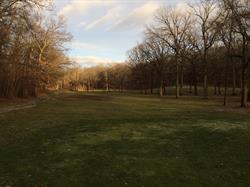
The Woods, seen from the Golf Course
Tucked into a quiet neighborhood in the hills of Ann Arbor’s east side you’ll find Huron Hills Golf Course Woods, one of Ann Arbor’s hidden gems. It would be easy to miss if you didn’t know about it. Like many of our nature areas, you have to either be very local or purposefully seek this place out to discover it. However, it’s well worth discovering.
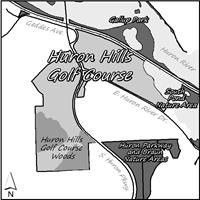
Huron Hills Golf Course was designed in 1922 by the "Johnny Appleseed of American Golf" Tom Bendelow. Visiting the hilly back 11 holes on the west side of Huron Parkway is a great way to get out and explore nature. The woods includes many large oaks nearing the 100+ year mark, thanks to the creation of the golf course. I have to agree with Doug Kelly, the City’s Director of Golf, who called this "a beautiful secluded area."
There are two separate woodlands that hug holes 12 to 16 of the golf course. The west one is larger at nearly 13 acres and has an interpretive loop trail with a park bench and native woodland plant garden, courtesy of an Eagle Scout project. From this main loop there are more than a few trail offshoots leading to the golf course. The woods is best accessed from Hunting Valley Road between Foxcroft Road and Provincial Drive. The nondescript trail entrances are easy to miss so drive slowly. You can enjoy a nice stretch of the legs hiking along the hilly wooded ravines here. You’ll find stands of Concolor fir (Abies concolor) trees with soft, pale blue-green tinted needles that are the same color on both sides. These trees are native to western North America, but are planted in Michigan horticulturally and for Christmas trees. They are not considered invasive here, and this is one of the few populations in our nature areas.
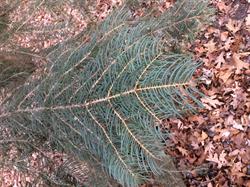
Concolor Fir
The east side woodland is slightly smaller, at just over 10 acres. It adjoins the busy Huron Parkway, where you can hop off the sidewalk onto a trail that takes you through gently rolling hills, past glacial erratic granite boulders, and along a small wetland eventually leading to the end of the fairway for hole 13.
Course managers have been working to add a continuous path for golf carts over the last year or two. This new crushed gravel surface makes a very handy walking path skirting the edges and linking the two sides of the woods for a longer hike. "We welcome walkers (on this path) December 15th through March 1st but don’t want anyone getting hit by golf balls," said Kelly. Use caution and respect golfers when visiting this area in warmer months.
Another great activity in this area is downhill sledding. I often drive by and see families zooming down the hills tucked between the woods on snowy days and wish I could join them. If you’re looking for a new sledding hill come next winter, this is supposedly one of the longest hills in the city without being too steep for comfort. You can access the sled area by parking at the golf course and crossing Huron Parkway at the crosswalk by Huron River Drive.
The woods are mostly open and relatively free of invasives. This spring you’ll be rewarded with plenty of the usual suspects for spring wildflowers, including the not-so-commonly seen early-blooming Dutchman’s breeches (Dicentra cucullaria), the flowers of which look exactly like little white pantaloons hanging upside down, with miniature yellow petals on the flower tips. Flowering dogwood trees (Cornus florida) are here to enjoy as well. There is also a population of the native wood
poppy (Stylophorum diphyllum), not to be confused with the invasive celandine (Chelidonium majus). You can tell the difference by the densely hairy elliptical seedpods of the native vs. the long, smooth seedpods of the invasive.
.jpg?RenditionID=6)
Dutchman's Breeches
Another great feature of the woods is the remarkable diversity of bird species found there, especially considering the small acreage. Few small parks anywhere are a breeding home for some of these species, including Acadian Flycatchers and Cerulean Warblers. Wood Thrushes have been found here too and, during migration, Connecticut Warblers. This could be due to the high quality of woods, or because the area is home to some remnant populations of these birds.
So, the next time you’re cruising along Huron Parkway between Washtenaw Avenue and Huron River Drive, look to the west where it gets hilly to glimpse the scenic views of the woods surrounding the golf course. Hopefully you’ve been inspired to get out and discover this park for yourself – there’s a lot to see and do in all seasons!
Join us at Huron Hills Golf Course Woods for Garlic Mustard Weed-Out Day, May 18. See the back page for more details.
Coordinator's Corner: Hindsight is 20-20
Dave Borneman, Natural Area Preservation Manager
I was recently re-reading some books about wilderness by one of my favorite authors, Sigurd Olson. If you don’t know Sig, he was a prolific author, a professional canoe guide, and the person most responsible for the creation of the Boundary Waters Wilderness Canoe Area in northern Minnesota. Sig was an alumnus of my school – Northland College – so we read many books about his wilderness experiences. In school, we learned about "leave no trace" camping. So imagine my shock when I read Sig’s account of paddling into a wilderness camp site back in the 1950s, making himself a bed of fresh-cut pine boughs, and then, after a peaceful campfire dinner watching the sunset, filling an empty pork-n-beans can with rocks and throwing it out into the lake! How could a leading proponent of wilderness do that!? What was Sig thinking!? Was that really considered to be a "best practice" back then?
And then I remembered the great Aldo Leopold – considered by many to be the Father of the modern field of Ecological Restoration. You may be familiar with his famous book, A Sand County Almanac, which got many of us thinking about our own Land Ethic and society’s views of nature. Aldo wrote about his experiences restoring an old beat-up farm in the barren sand counties of central Wisconsin. This book has been another bible for people in my profession since it was published in 1946. What was Aldo’s method for restoring this land? Did he hand-collect native species of plants within a tight geographic area to maintain the local genotype? No, he planted 40,000 red pine trees in a straight rows. That was considered revolutionary and cutting-edge at the time - a novel attempt to stop erosion and help the land heal. But we wouldn’t consider it to be cutting-edge today. We have our own old pine plantations in Bird Hills and Marshall Nature Areas, and we’re trying to figure out what to do with them now. It must have made sense to someone at the time to plant them. But what did they expect us to do with this unnatural monoculture of evenly spaced pine trees after they got big? Rows of even-aged pines laid out in a grid sure doesn’t seem like ecological restoration to us now. What were they thinking!?
Well, it’s nice now to be on the wiser side of these situations. I would never throw my old cans into the lake when camping. And I’d never plant a pine plantation and call it ecological restoration. Yet I am confident that at some point in the future, someone will look back on our current stewardship activities here at NAP and wonder the very same thing: What were they thinking!? Ecological restoration is an iterative process. We learn from our mistakes. We take the information at hand, consider the best science available today, and make our best, informed decision on how to proceed. Then we look at the results, re-evaluate, make changes where needed, and try again. On and on it goes. Hopefully getting ever closer to the best possible solution to the problem, even though that problem is, itself, always evolving and getting more complex.
So, I’ll try not to judge the actions of Sig or Aldo by today’s standards. And I hope future generations will be as forgiving of me and NAP and what we think are the right decisions in ecological restoration that we are making today.
Oh Deer: A Sampling of Deer-Resistant Plants
Morgan Boyer, Deer Management Education Specialist
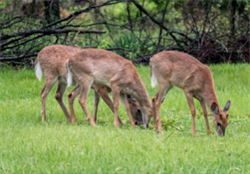
Deer browsing on a lawn
Many of us enjoy gardening, whether it’s to provide food and habitat for bees and birds, to harvest home-grown vegetables and fruits, or just because it helps us connect to the outdoors. As spring unfolds, we are planning to spruce up our garden beds. However, sometimes gardens attract white–tailed deer, that, for a variety of reasons, may find them to be a botanical buffet. So how can we maintain an interesting and vibrant garden while co-existing with the local herd? A solid foundation of deer-resistant plants is a great place to start!
First, we have to acknowledge that no plant is known to be immune to deer browse. If it has been an especially harsh winter, if there are a lack of suitable alternative food sources, or if the herd population has increased substantially you may find even the toughest of coneflowers browsed. Second, choosing native plants is the surest bet, as these plants are best-suited to the conditions of Ann Arbor's soils and climate, making them most likely to establish themselves well in your garden. Please keep in mind that when planting native plants it is always best practice to use seeds or plants that are of the local genotype, so get them as locally as possible.
Deer do have their favorite plants to browse, and they're more attracted to places where their preferred food is easily available. Fresh spring flowers (like crocus and forsythia), plants with high water content (like hostas), and plants that produce sweet berries (like strawberries), will all attract deer. So avoid these plants or be prepared to defend them with fencing and deterrents!
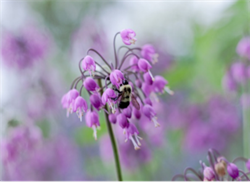
Nodding onion
Don’t despair, there are many plants that are heartily deer-resistant and suit a variety of interests. Plants such as clammy-weed, nodding onion, and wood-sage all produce powerful scents that deer are reluctant to walk through, as the scent will linger on the deer and could potentially give them away to would-be predators. Some plants are simply unpalatable and not attractive for the deer to eat, such as most milkweeds, black cohosh, and royal fern, whose latex sap and astringent powerful flavors are off-putting to deer. Other plants, such as Virginia ground cherry and common elderberry, produce toxic chemicals in their foliage that will put off just about any herbivore.
So what could you plant if you want to kick off a pollinator garden that will last for more than one season? Some recommendations are wild columbine, foxglove beard-tongue, and golden Alexander. If you want to try your hand at a vegetable and fruit bed, perhaps try rhubarb, squash, or raspberries. If you’re like me, though, and looking for something fun and flashy, winterberry, little bluestem, and wood fern will do the trick and will help give your garden a little color through every season.
Remember, each herd eats differently, so what works for you may not work for your friend across town. Be willing to experiment, but do keep these deer-repelling characteristics and plants in mind when looking for a new plant for your garden. For more potential plant selections, please look into the deer-resistant plant guide the city has created to further support your gardening needs, found at: www.a2gov.org/deermanagement. Deer-resistant plants are just one way to help deter deer from your beloved garden bed, but there are plenty of other tips and tricks! If you have any further questions, please call the deer management hotline at 734.794.6295 or email staff at [email protected].
**UPDATE
Since the publication of this newsletter, NAP has heard reports that some of the species described here as being "deer-resistant" are actually being browsed heavily in the Ann Arbor area. For a more complete discussion of this issue, and for a more complete listing of potenitally deer-resistant plants, refer to the Deer Management Gardening Guide.
NAPpenings
Welcome new Park Stewards!
Molly Brookshire
Pittsview Park
Lisa Johnson
Miller Nature Area
Victor Morales-Rios
Traver Creek Nature Area
Thank you!
Many thanks to the groups who volunteered with NAP recently. We could not make such a difference without you!
Boy Scouts of America Troop 5
Boy Scouts of America Troop 457
EMU Circle K International
UM Community Scholars Program
UM Environ 201 Class
UM Epsilon Eta
UM Phi Chi
UM Sigma Chi
UM Wesley Foundation
City Nature Challenge, April 26th- May 5th
City Nature Challenge is a global project dedicated to recognizing the wonderful wild things that make your community worthwhile! Join over 170 cities and see who can make the most observations of nature, who can find the most species, and who can engage the most people in their community. Find out more and sign up to participate by going to iNaturalist.org and searching "City Nature Challenge 2019: Ann Arbor".
Staff Updates
Farewell...
 Chris Robey, Field Crew
Chris Robey, Field Crew
Time sure does sneak up on you! I want to express my heartfelt gratitude for the last ten months with NAP. For the next few months, I'll be in Colorado, teaching high school English for the High Mountain Institute. Come fall of next year, I hope to begin working toward a Master of Landscape Architecture degree. I owe thanks for this experience as much to the people as to the woodlands, wetlands, and prairies we've worked to protect and restore. You've made this all worthwhile. A fond farewell to you my friends. It's been an honor and a pleasure.
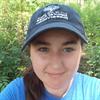 Kayla McGuire, Field Crew
Kayla McGuire, Field Crew
While I am sad to be leaving, I am very grateful for all the opportunties I have recieved while working at NAP. I look forward to participating in workdays and controlled burns as a volunteer who has learned so much abou tthe natural world around me. I hope that one day my work will again allow me to partner with NAP for the progression of environmental stewardship. I'd like to extend a huge thank you to everyone who took the time to teach me so many things during my time here.
Welcome...
 Sean Levin-Pompetzki, Field Crew
Sean Levin-Pompetzki, Field Crew
Growing up in southeast Michigan, I always watned to be a part of protecing, preserving, and restoring the natural world. I starting doing this type of work as a volunteer in college. I have also done natural resource work for the Forest Service in the summers of 2017 and 2018. I am excited for the opportunity NAP has given me to continue doing this work. I am excited to be able to share my love and interest in the natural world with the city of Ann Arbor.
 Hart Davis, Field Crew
Hart Davis, Field Crew
As far back as I can remember, I have been drawn to the natural world. I graduated from Albion College with a bachelors degree in biology. Since graduation I have served in AmeriCorps, working alongside the Michigan DNR on forestry and wildlife projects, and with the Conservation Corps at the Bosque Del Apache wildlife refuge in New Mexico, conducting field camera studies on the endangered New Mexico Jumping Mouse. I look forward to working with NAP and improving Ann Arbor's natural areas!
Would you like to be part of the NAP Staff team? Follow the city jobs website (a2gov.org/jobs). Positions can open throughout the year.
NAP also has unpaid internships that provide valuable experience! For internship information contact NAP directly: [email protected] or 734.794.6627.
21st Annual Garlic Mustard Weed-Out Day
Saturday, May 18, 2019, 9 a.m. to noon
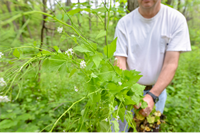 Garlic Mustard Weed-Out Day is an annual tradition where volunteers hand-pull garlic mustard in natural areas all around Ann Arbor. Garlic mustard is an aggressive Eurasian invasive species that can quickly crowd out native plant species and decrease natural diversity in the woods. Identifying and pulling garlic mustard is fun and easy for all ages, making this a great opportunity for families.
Garlic Mustard Weed-Out Day is an annual tradition where volunteers hand-pull garlic mustard in natural areas all around Ann Arbor. Garlic mustard is an aggressive Eurasian invasive species that can quickly crowd out native plant species and decrease natural diversity in the woods. Identifying and pulling garlic mustard is fun and easy for all ages, making this a great opportunity for families.
Participating Parks:
Argo Nature Area- Meet in the parking lot north of the Argo Canoe Livery, off Longshore Drive.
Black Pond Woods Nature Area- Meet us on Tibbits Court, off of Pontiac Trail.
Hannah Nature Area- Meet at the west end of Bath Street, off Seventh, just north of West Huron Street.
Huron Hills Golf Course Woods- Meet us on Hunting Valley Road, off Provincial Drive.
Huron Parkway Nature Area- Meet at the Park Stewards' house: 3470 Woodland Road, off East Huron River Drive.
Leslie Woods Nature Area- Meet us at the park entrance at the north end of Upland Drive, north of Plymouth Road.
